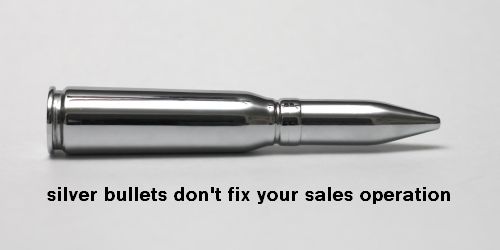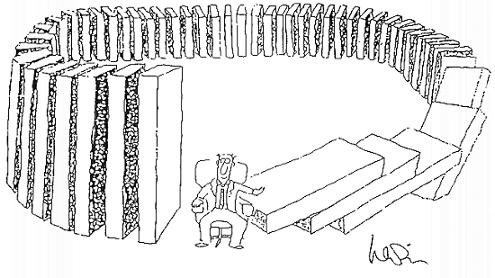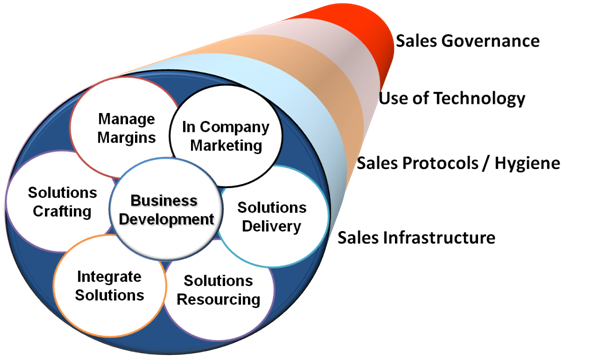
What is a Point Solution? A point solution solves one particular problem without regard to related issues. Point solutions are usually called for when there is a need to fix a specific problem or fast-track the implementation of a new service. Unfortunately, point solutions often don’t deliver meaningful or sustainable results. The sales training/consulting industry is littered with point solution providers, all promising ‘sales excellence in a box’ ranging from the latest selling style [1] you must adopt to a New York best seller book promising the golden nugget that will turn your sales around. When it comes to improving sales operations training is the point solution of choice – and often “any training” will do. And if it is not training then it’s a CRM point solution that will solve all of the sales ills. This has been going on for more than 70 years. While it’s fair to say that some of the content in these point solution offerings is useful it would not be fair to say that, on its own, a point solution can improve anything for long, let alone something as complex and dynamic as a sales organisation.  The challenge of point solutions is the outcome of unintended consequences. For instance, a point solution could be to train sales people to be more productive i.e. better at prospecting for new business. So your sales team is trained and now they go and get more business, however, the business systems and operations have not been geared to support the increase in new business thus leaving sales people frustrated and customers disappointed. Large organizations are the worst offenders when it comes to point solution overload. Preyed upon by vendors offering the latest in sales excellence, you can find several different point solutions that do not talk to each other or, worse still, compete with each other therefore littering sales processes, sales language, sales systems and sales people with conflicting information. All this does is create more confusion for the sales teams who are often trying to report on 15 or so different sales metrics that make no sense and keep them from doing what they are paid to do – sell. Ironically many of these point solution vendors come off as nothing better than snake oil salesmen themselves – offering sales salvation in a box (or training, or software, or assessments, or coaching, or technology, etc .) You know what I mean. So why do business leaders continue to let point solutions take precedence over a more a considered, integrated and strategic approach? There are three main reasons:
The challenge of point solutions is the outcome of unintended consequences. For instance, a point solution could be to train sales people to be more productive i.e. better at prospecting for new business. So your sales team is trained and now they go and get more business, however, the business systems and operations have not been geared to support the increase in new business thus leaving sales people frustrated and customers disappointed. Large organizations are the worst offenders when it comes to point solution overload. Preyed upon by vendors offering the latest in sales excellence, you can find several different point solutions that do not talk to each other or, worse still, compete with each other therefore littering sales processes, sales language, sales systems and sales people with conflicting information. All this does is create more confusion for the sales teams who are often trying to report on 15 or so different sales metrics that make no sense and keep them from doing what they are paid to do – sell. Ironically many of these point solution vendors come off as nothing better than snake oil salesmen themselves – offering sales salvation in a box (or training, or software, or assessments, or coaching, or technology, etc .) You know what I mean. So why do business leaders continue to let point solutions take precedence over a more a considered, integrated and strategic approach? There are three main reasons:
- There is no formal education where business people can learn and understand all the elements involved in running something as complex as sales operations. For instance, in the conventional MBA program you would spend as few as 18 hours on the theory of selling out of a total of 425 days of study. No wonder people do not understand the complexity of selling, the sales value chain, sales strategy, etc. So when you don’t understand something you look for the easiest fix to your issue – hence the market for the quick fix point solution in the absence of real education.
- For many years the USA was seen as the Mecca for sales solutions with people thinking ‘if it is from the USA it must be good’. [2] Many point solution vendors hail from the USA. Why? Well, the USA is such a huge market place that many purveyors of point solutions are able to make a great living shopping their ‘solutions’ in a relatively small geographic area with a huge population. They are able to move around for years from one client to the next without really improving sales operations. What they leave behind is a trail of the illusion of sales improvement. When the short term effects wear off the client has to keep looking for more solutions and the cycle continues.
- The use of expert language and terms in sales has created nothing but confusion with people speaking in clichés and slogans. You constantly need to decipher what people mean. For instance, one person’s version of being strategic is unlikely to be the same as someone else’s. Point solution vendors create terms and language to differentiate and make a name for themselves but only leave people unable to communicate with each other on what are the fundamentals of sales and sales operations. It’s a bit like the bible story about the Tower of Babel where no one could understand one another.
The brutal facts are that building and improving sales operations is multi-faceted and complex – it is a dynamic process that is changing constantly. What is vital is that organisations have a clear vision that directs their strategy and creates focus that in turn drives the right actions and behaviours. The vision is critical. Whilst strategy changes as we navigate around obstacles the vision should be immutable. To give a sales operation the focus, tools and capability to navigate their way towards the vision there needs to be core fundamentals in place.  Running an effective sales operation is not easy. The well validated Sales Atom is an excellent framework on which to build and improve sales organisations. The Sales Atom is a unique value chain for sales consisting of revenue generating activities and revenue absorbing functions. A strategically aligned organisation is usually one that gets the appropriate balance of effectiveness (i.e. doing the right things) in its revenue generating activities and the efficiencies (i.e. doing things right) in its revenue absorbing functions. So beware of the point solution, it may sound like the ideal fix but unless it is integrated into a sound sales framework you are likely wasting your money, time and effort. In short, you cannot change, fix, develop or cultivate an effective sales operation with a point solution approach.
Running an effective sales operation is not easy. The well validated Sales Atom is an excellent framework on which to build and improve sales organisations. The Sales Atom is a unique value chain for sales consisting of revenue generating activities and revenue absorbing functions. A strategically aligned organisation is usually one that gets the appropriate balance of effectiveness (i.e. doing the right things) in its revenue generating activities and the efficiencies (i.e. doing things right) in its revenue absorbing functions. So beware of the point solution, it may sound like the ideal fix but unless it is integrated into a sound sales framework you are likely wasting your money, time and effort. In short, you cannot change, fix, develop or cultivate an effective sales operation with a point solution approach.
[1] There are many sales styles that have been touted as the ‘ideal’ sales style over the years. Think mood selling, barrier selling, formula selling, needs satisfaction selling, consultative selling, solution selling; these are, all forms of selling practice across the last 100+ years. The latest is a derivative of needs satisfaction selling called Challenger Selling. And while this style does make valid points, none are actually revolutionary or innovative, rather it is a progression on the insights into needs satisfaction selling. Solutions Selling is by far the most effective selling practice. Some reports indicate that “solutions selling” has past its sell by date. The reality is that solutions, as opposed to products, are precisely what buyers (customers and prospects) are looking to purchase. (see our article on ‘Solutions Selling isn’t dead‘). [2] Knowing what makes sales people tick is critical for finding and keeping top producers. The implications are serious and far-reaching, especially when it comes to multinational sales management practices. American sales management, training and procedures adhere to US presupposed values and perceptions, and may not be optimal, or even suitable, for other countries. It is often better to access country and culturally specific training for your sales people. Remember everybody lives by selling something. Author: Sue Barrett, www.barrett.com.au


New Article Email Notification